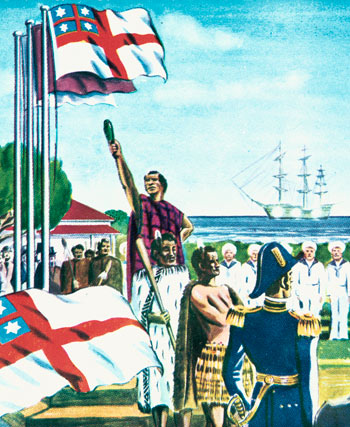Story summary
In the early 1800s, before New Zealand was a British colony, many European traders, whalers and settlers arrived here. Because of concerns about the behaviour of some Europeans, and the lack of laws to govern them, the British government appointed James Busby to be an official ‘British Resident’. Busby arrived in Waitangi, in the Bay of Islands, in 1833.
United Tribes’ flag
Ships needed to fly a flag of a country, but New Zealand didn’t have a national flag and a New Zealand-owned ship had been seized in Sydney for not flying a flag. In March 1834 Busby called together chiefs in Northland to decide on a flag. They were presented with three options, and the one they chose became known as the United Tribes’ flag. Busby hoped this might encourage different tribes to work together.
Declaration of Independence
In the 1830s the British were concerned that France or the United States might try to claim New Zealand. Because of this, in 1835 Busby, with help from missionaries Henry Williams and William Colenso, drafted a statement for chiefs to sign in which they declared themselves rulers of New Zealand. The version that was signed was in Māori, but an English translation was also made.
What the declaration said
The declaration had four articles:
- In the first article the chiefs declared New Zealand a ‘w[h]enua rangatira’ (independent state).
- The second stated that the ‘kingitanga’ (sovereign power) was held collectively by the chiefs.
- The third article said a huihuinga (congress) would meet in autumn each year to make laws and decisions.
- The fourth article said a copy of this declaration would be sent to the king of England and asked him to be a parent of the infant state.
After the declaration
The declaration was sent to King William IV and was recognised by Britain.
Other chiefs signed the declaration up until 1839. In 1840 te Tiriti o Waitangi was signed and New Zealand became part of the British colony of New South Wales.





